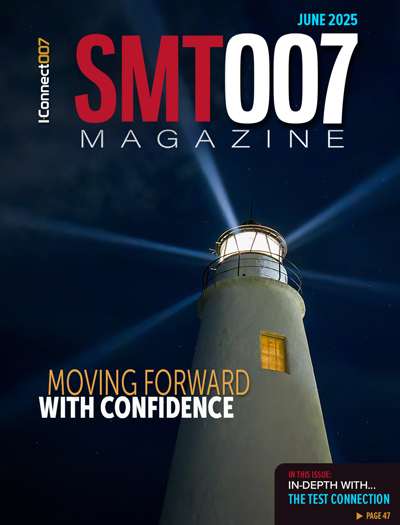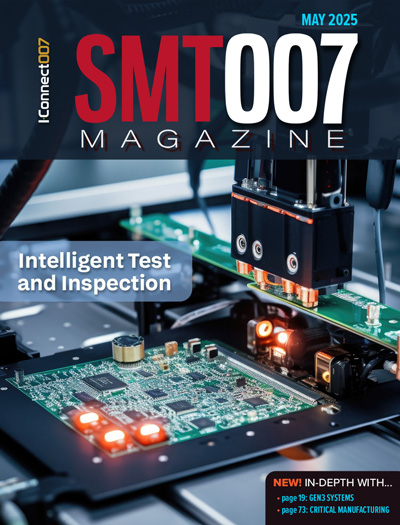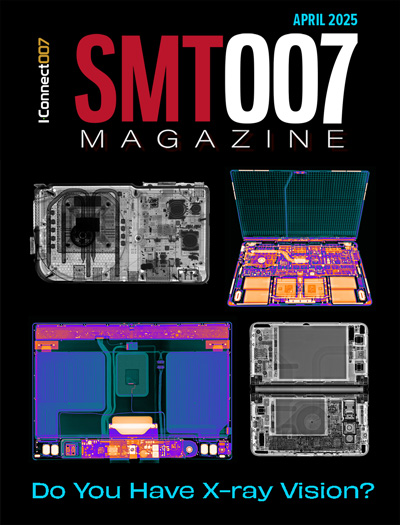-

- News
- Books
Featured Books
- smt007 Magazine
Latest Issues
Current Issue
Moving Forward With Confidence
In this issue, we focus on sales and quoting, workforce training, new IPC leadership in the U.S. and Canada, the effects of tariffs, CFX standards, and much more—all designed to provide perspective as you move through the cloud bank of today's shifting economic market.

Intelligent Test and Inspection
Are you ready to explore the cutting-edge advancements shaping the electronics manufacturing industry? The May 2025 issue of SMT007 Magazine is packed with insights, innovations, and expert perspectives that you won’t want to miss.

Do You Have X-ray Vision?
Has X-ray’s time finally come in electronics manufacturing? Join us in this issue of SMT007 Magazine, where we answer this question and others to bring more efficiency to your bottom line.
- Articles
- Columns
Search Console
- Links
- Media kit
||| MENU - smt007 Magazine
IPC APEX EXPO 2025 Review: The New Normal Looks Like the Old Normal
April 16, 2025 | Nolan Johnson, SMT007 MagazineEstimated reading time: 5 minutes
At IPC APEX EXPO, my days are filled with either talking or listening from sunup to sundown. I get to answer questions of some of the brightest minds in the business, while also listening and synthesizing what they’re sharing with me about the current and future state of the industry. Here are five observations based on the conversations.
- The industry is optimistic. Even in the face of uncertainty, buyers and vendors are moving forward with their plans. As one industry insider said, “If they have a strategic plan at all, they’re still executing on it.” The sentiment seems to be that the upward trend might be shifted by current changes in economic policy coming out of the U.S, but it will not be squelched by it. Naturally, the trade in equipment seemed brisk on the show floor.
- The EMS Leadership Summit is improving in value and insight. I’ve had the pleasure of attending several of these summits, and each year the agenda gets better. Mark Wolfe, Tracy Riggan, and the rest of the planning committee dial in the program with every iteration. If the objective of the summit is to bring EMS industry leadership together to network, build better working relationships, and to share the latest industry information, then the summit team raised the bar again this year. I highly recommend attending next year’s daylong event.
- The developments in adjacent tech sectors will change our manufacturing techniques. It has always been the case that adjacent industries—semiconductor manufacturing for example—influence our industry. New component packages are an obvious example. Devan Iyer, IPC chief strategist for advanced packaging, Dr. Ahmed Bahai, chief technology officer at Texas Instruments and one of the keynote speakers, discussed with me at length about the new developments in packaging. The themes in the conversation suggest not a trickle-down but rather a cascading chain of events that will change the components we will handle. Another key development is shrinking feature sizes on the PCB, for which some of the older semiconductor manufacturing technologies come increasingly into play—for example, interposers. Consequently, some of our PCB fabs are starting to look like the early semiconductor fabs—and they should. We’re fabricating in those same feature sizes on the board nowadays that used to be on the chip. New materials require new methods, while some require minor tweaks, and others require the installation of entire lines. New software tools for process control, sensing, tracking, inventory management, scheduling, and more, continue to move us deeper into the reality of Industry 4.0. Which leads me to AI.
- Artificial intelligence is here to stay and soon enough will earn its keep. I discount generative AI, however. It’s getting all the hype in the mainstream and will likely follow the traditional hype curve. Sure, it has a place, but all we have to do is look at Ben Rachinger’s award winning paper from this year’s conference to see that AOI data sets not only can be shared between multiple companies through a federated library to build a more powerful large language model, but that the data can also be stored in tokens, protecting the proprietary nature of the source data. The unexpected insights coming from AI LLM implementations which are properly used is nothing less than mind-boggling. In focused industrial applications, predictive analysis based on seeing patterns in past data so subtle that humans cannot identify them, will be disruptive. Disruptive in a good way.
- Regional diversification seems to be unstoppable. Sure, opinions differ on whether regional development is good for the industry, but it seems like those who are building up infrastructure are bullish, while those losing market share are bearish. India, SE Asia, and Mexico continue to build out. While it’s true that much of the investment in these three regions was originally to support automotive and EVs, the available capacity outside China seems to be attractive to OEMs looking to reshore.
Another sign of regional vibrancy is the increased involvement of Japan and SE Asia in IPC standards work, etc. Sydney Xiao, IPC president of North Asia, highlights this trend in her Real Time with… interview.
Thirty years ago, the PCB portion of the electronics industry was a thriving network of businesses: Many family-owned or similarly small serving a local/regional customer base. This was when the OEMs took a much more active role in moving their designs into fabrication and manufacture. A key part of that highly resilient supply chain was that OEMs of a certain size would build their own fab and EMS facilities, keeping manufacturing in-house and customized to their products. But then, on a global scale, we threw up obstacles and diverted most of the business to one central region.
In the western United States, we’ve been removing dams from our riverways. Built originally for various well-intentioned but obsolete purposes, these dams persist in disrupting an ecosystem while no longer providing any benefit in return. It is a biologist’s dream to study how a river ecosystem rebounds once the dam is demolished. While it’s no surprise that the original ecosystem returns; what is surprising is the rapidity and the robustness with which the regional diversity recovers. Rivers for which the dam had wiped the native salmon population for a hundred years, now have salmon returning to spawn as little as three years later1.
Like the rivers, our regional diversity is returning. As Chris Mitchell, IPC vice president of global government relations, said in his interview with I-Connect007, the world wholeheartedly embraced free trade after the fall of the Berlin wall. It can be argued that we overdid it, resulting in optimizing the resilience out of our supply chains, diverting too much economic flow away from its natural course, as it were. Chris suggests that the pendulum is swinging back to encourage more regional competitiveness. Alison James, IPC senior director for Europe, has been speaking with us about IPC Europe’s work with the European Union’s electronics competitive compass. After hearing their remarks, I could see the parallels to the dam removal projects: We need to clear out the barriers, obstacles and diversions, while also paying attention to sustainability, in order to re-establish a thriving ecosystem. It was my take-away that the competitive compass work seems intent to remove key strategic economic dams so that European manufacturing can once again flow.
There is no doubt, this is an exciting time to be in electronics manufacturing. Virtually every aspect of our industry is moving solidly (finally) into the 21st century. It’s about time.
References
1. I asked Grok to fact check this claim, only to find out that river biologists reported migratory fish returning in just weeks or months if the conditions were right.
This article originally appeared in the April 2025 issue of SMT007 Magazine.
Suggested Items
I-Connect007 Editor’s Choice: Five Must-Reads for the Week
06/13/2025 | Marcy LaRont, I-Connect007Today is Friday the 13th, and in much of Western folklore, this is a day when bad luck is lurking. But while Friday the 13th may top Western superstition charts, the global calendar is sprinkled with its own unlucky legends. In Spain and Greece, the bad juju lands on Tuesday the 13th—a day linked to Mars, the god of war, and naturally, chaos. In Italy, it’s Friday the 17th that is feared, thanks to the Roman numeral XVII, which can be rearranged to spell VIXI—Latin for “I have lived” (a poetic way of saying you’re dead).
Priority Software Appoints Ben Karniel as Chief Revenue Officer to Spearhead Global Growth
06/12/2025 | Priority SoftwarePriority Software, a leading provider of scalable and agile cloud-based business management solutions, proudly announces the appointment of Ben Karniel as its new Chief Revenue Officer (CRO), effective May 1, 2025. This strategic addition to the executive team underscores Priority's commitment to expand its global footprint.
Roll-to-Roll Technologies for Flexible Devices Set to Grow at 11.5% CAGR
06/11/2025 | GlobeNewswireAccording to the latest study from BCC Research, the “Global Markets for Roll-to-Roll Technologies for Flexible Devices” is expected to reach $69.8 billion by the end of 2029 at a compound annual growth rate (CAGR) of 11.5% from 2024 to 2029.
Nordson Electronics Solutions Develops Panel-level Packaging Solution for Powertech Technology, Inc. That Achieves Yields Greater Than 99% for Underfilling During Semiconductor Manufacturing
06/11/2025 | Nordson Electronics SolutionsNordson Electronics Solutions, a global leader in reliable electronics manufacturing technologies, has developed several solutions for panel-level packaging (PLP) during semiconductor manufacturing. In one particular case, Nordson’s customer, Powertech Technology, Inc. (PTI) saw underfill yields improve to greater than 99% as they plan to transition from wafers to panels in their manufacturing operations. edwd
Bridging the Knowledge Gap in Test: A Conversation with Bert Horner
06/11/2025 | Barry Matties, I-Connect007Bert Horner is a seasoned industry veteran and co-creator of The Test Connection, Inc. (TTCI), a test and inspection company spanning over 45 years. In this candid conversation, Bert reflects on the challenges our industry faces with the retirement of career professionals and the subsequent loss of critical tribal knowledge. As he unveils The Training Connection’s innovative training initiatives, Bert emphasizes the importance of evolving educational programs that align with industry needs, particularly in design for test (DFT), and sheds light on strategies being implemented to foster the next generation of engineers.


